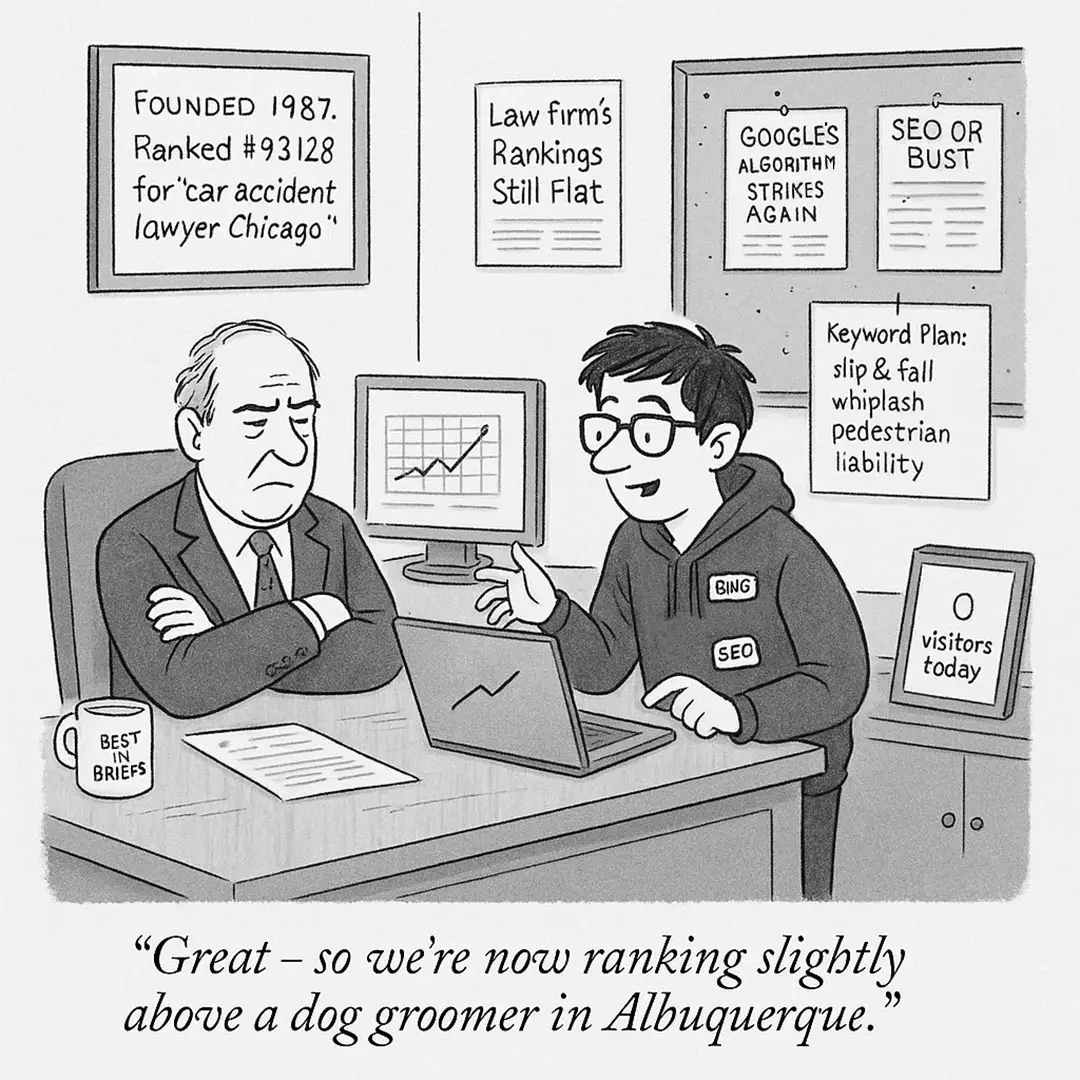The digital age has changed the way personal injury lawyers reach prospective clients. While some traditional strategies might maintain value, you must have a presence in the digital landscape. A big part of that is having a website. However, your website won’t do much good if people never find it. That is where personal injury law firm SEO services offer immense value.
Most personal injury clients turn to Google or other search engines to find representation. With personal injury lawyer SEO, you can ensure your site ranks high and has the visibility it needs. But there’s more to it than just using a few keywords. It involves a variety of strategies you must implement thoughtfully and consistently.
Don’t worry if law firm SEO seems a little complex or overwhelming. We’ll walk you through it. You just need to be ready to put in the time and effort to implement the strategy.
At ReadTomato, we are experts at SEO for personal injury law firms. Our team can handle all phases to develop a customized strategy that will help your firm stand out. Reach out now to learn more in a consultation.
The Core Elements of SEO for Law Firms
In basic terms, search engine optimization is a range of practices to increase a website’s visibility in search engines. Google is typically the primary target since it’s the largest search engine, but there are others.
The goal is to increase the quality and quantity of traffic to your site by ranking higher in relevant search results. For personal injury lawyers, this means appearing when potential clients search for terms like “personal injury attorney” or “car accident lawyer.” However, there are myriad terms your firm might want to rank for.
SEO involves several key elements, including keyword optimization, content development, user-friendly website design, and backlinking. When done effectively, these practices help search engines understand your website and rank it higher for relevant searches.
That makes SEO for personal injury attorneys essential to reaching potential clients looking for representation. Without SEO, even the best law firms may remain invisible to those who need them.
For this post, we can divide SEO for law firms into four categories: On-Page SEO, Off-Page SEO, Local SEO, and Technical SEO. Let’s take a closer look at these categories.
On-Site SEO for Personal Injury Lawyers
On-page SEO refers to all the optimization efforts on your website. These are the elements you control and implement to help search engines understand your content and rank it. Key on-page SEO elements include:
- Keyword Research: Identifying relevant terms potential clients are searching for and incorporating them naturally throughout your content.
- Publishing Optimized Content: Creating valuable, informative content tailored to your audience and optimized for search engines.
- Internal Linking: Connecting pages within your website to guide visitors to more relevant information and improve site navigation.
- Site Navigation: Ensuring your website is user-friendly and easy to navigate so visitors can quickly find the information they need.
- Title Tags and Meta Descriptions: Crafting concise, keyword-optimized title tags and meta descriptions that encourage click-throughs from search results.
- SEO-Friendly URLs: Structuring URLs that are clean, descriptive, and optimized for search engines.
- External Linking: Linking to reputable websites enhances your content’s credibility and adds value.
That is a brief overview of on-page SEO. Our in-depth guide explains it in more detail.
 Off-Page SEO for Law Firms
Off-Page SEO for Law Firms
Off-page SEO covers the optimization efforts that take place outside your website. The idea is to build a presence outside your site to increase trust and credibility. Having a larger presence outside your website can raise its profile and boost search rankings.
A significant part of off-page SEO is building backlinks. These are links from other websites that point to your content. Backlinks signal to Google and other search engines that your pages are useful, authoritative, and relevant. With more high-quality backlinks, your site will rank higher in search engine results. However, earning backlinks isn’t always easy, requiring deliberate efforts and strategies to be effective.
Here are some key strategies for acquiring backlinks:
- Guest Blogging: Writing articles for other websites in exchange for a backlink is an effective strategy. Choose reputable sites to maximize the value of these links.
- Media Outreach: Reaching out to journalists and media outlets for mentions or features in news articles can help you gain valuable backlinks.
- The Skyscraper Technique: This strategy involves finding popular content in your niche and creating something better. You can then contact the websites linking to the original content to suggest your superior content as a replacement.
- Broken Links: Find broken links on other websites and offer your content as a replacement. That helps the website fix an issue and earns you a backlink.
- Create Attractive Assets: Producing high-quality content, like infographics, eBooks, or research reports, encourages others to link to your website.
Beyond backlinks, there are other ways to enhance off-page SEO for personal injury lawyers. Social media activity plays a key role in increasing your brand’s visibility. It can also boost SEO by attracting visitors to your content. Online reviews can also help, as positive reviews build trust and credibility, influencing search engine rankings. Engaging in forum participation or community building in relevant online spaces can further expand your digital footprint.
However, off-page SEO is complex. To learn more, read our guide to off-page SEO for personal injury lawyers.
Local SEO for Law Firms
Personal injury lawyers typically rely on clients from within a close geographic region. Modern search engines also consider location when serving search results to users. That means appearing in local search results is crucial to reaching potential clients in their area.
One key component is finding relevant local personal injury keywords. Many of these might be things like a practice area with the geographic region attached. For example, it might be “truck accident lawyer in Chicago” for lawyers in that area. However, it could be any number of root keyword combinations with locations.
Another vital point for successful local SEO is to claim and complete your Google Business Profile. The profile is free, and it can do much to help Google understand your business and its website. It ensures that Google recognizes your firm as a local business in your target region. With a complete profile, you can also ensure you appear in local search results and Google Maps.
Take the following steps to claim and complete your Google Business Profile:
- Claim your Google Business Profile to take control of your listing. You can do this through a simple process in Google Maps.
- Fill out every section with accurate information. Include business hours, your address, services offered, and contact information. You might also want to add photos to the profile.
- Post regular updates or content to keep your profile active. Updates and content signal to Google that your firm engages with its local audience.
- Encourage and respond to client reviews. Client reviews not only build trust but can also boost your profile in search results. Respond professionally and politely to both positive and negative feedback.
The content you create for or add to your profile can help with personal injury SEO. By using relevant location-based keywords, you can ensure your profile ranks better in local search.
Personal injury attorneys should also consider expanding this strategy beyond Google. While Google dominates search, other search engines like Bing offer similar local business profiles. Bing might have a smaller user base, but it still reaches a significant audience. Many businesses overlook alternative search engines, making it a valuable opportunity to stand out from competitors.
You should create location-specific content on your website to further boost local SEO. For example, dedicated service pages for different cities or regions you serve can help your site rank higher. These pages should cover your practice areas and the specific locations to attract a targeted local audience.
Do you want to take a deeper dive into local SEO? Read our guide to local SEO for personal injury lawyers.
 Technical SEO for Personal Injury Attorneys
Technical SEO for Personal Injury Attorneys
With technical SEO, you focus on optimizing the technical elements of your site that visitors never see. Beyond performance metrics like speed, you must also cover crawlability and indexability. Addressing technical SEO ensures search engines can access your site and understand the content. While on-page SEO focuses on visible elements, technical SEO covers the back end.
Crawlability and indexability are key pillars of technical SEO. Crawlability refers to how easily search engine bots can find and navigate your website’s pages. Indexability concerns whether the search engine’s index can store and use the pages in search results. Improving these areas helps search engines better understand and rank your website.
That means you need to ensure search engine crawlers can access your site. We’ll cover ways to do this later in this post. Another point is to ensure internal linking that covers all core pages of your website. You should also submit an XML sitemap to Google Search Console.
However, beyond crawlability and indexability, website performance is also important for technical SEO. The following are common performance concerns that can affect SEO for lawyers:
- Core Web Vitals: These are Google’s key metrics that measure page speed, interactivity, and stability. Optimizing for these metrics is crucial for delivering a smooth user experience and improving rankings.
- Server Errors: Addressing server issues (like 400 and 500 errors) ensures that search engines and users can access your site without problems.
Technical SEO is complex. To learn more, check out our guide to technical SEO for personal injury lawyers.
The ReadTomato team offers expert services for personal injury law firm SEO services. From technical to local SEO, we can help your firm achieve its goals. Contact us now to get the top law firm SEO agency on your side!
How to do SEO That Works for Personal Injury Lawyers
Now, you understand the core elements of SEO for law firms. At this point, you might be wondering what you can do to deploy some of these strategies for your website. In the following sections, we’ll walk you through the essentials of developing and executing an SEO strategy for your firm.
From keyword research to getting backlinks, we’ll cover all the steps you need to get started. With a step-by-step approach, you’ll have a clear roadmap to move your site up the search rankings.
Make Your Website Visible to Search Engines
To make your personal injury law firm’s SEO efforts count, it’s crucial that search engines can index your website. Without proper indexing, your pages won’t appear in search results.
The first step is to check if your website and its pages appear in search results. You can do this by copying your site’s URL and searching it on Google. Look at the results to see if your pages are showing up. If they aren’t, there’s likely an issue preventing search engines from indexing pages on your website. However, if it’s a new site, it might be that Google hasn’t crawled the website yet.
If your site has been up for a while and still isn’t showing up, you’ll want to dig deeper. One common culprit is the misconfiguration of your robots.txt file. This file instructs search engines which parts of your website you want them to crawl and index. You might block crawlers from important pages if you haven’t set it up properly.
To check this, navigate to your website’s robots.txt file by typing yourdomain/robots.txt in your browser. Look for any rules that might restrict search engines from accessing key areas of your site. For example, if you see the “disallow” rule, it may be blocking the crawlers from indexing your website.
 Find Personal Injury Keywords
Find Personal Injury Keywords
Keyword research is one of the most crucial elements of personal injury lawyer SEO. With the right keywords, you can do more to ensure your website appears in the most valuable search results. You’ll get more traffic from people looking for representation when you rank high for those search results.
Common sense can provide a good start for finding the obvious keywords like “personal injury attorney” or “car accident lawyer.” However, you can develop keywords with more value by deploying various tools and strategies.
Consider using keyword research tools like Google Keyword Planner, Ahrefs, or SEMrush. These tools allow you to plug in a “seed keyword” to find more search terms. Seed keywords are the general terms you might use for your business. The keyword tools will take these and provide lists of high-value terms related to the seed keyword. They might also provide data like search volume and competition to help you gauge the value of search terms.
Another powerful method for finding valuable keywords is competitor analysis. By examining what keywords your competitors are ranking for, you can identify opportunities to target the same or similar terms.
You don’t necessarily need expensive tools for this. Start by manually browsing your competitors’ blogs and practice area pages. While browsing the pages, pay special attention to their titles and headings. For example, you might see a blog titled “How to File Premises Liability Claim in Cleveland.” They are likely targeting “premises liability claim” with that post. You could then create content to target that keyword or similar ones.
Even without paid tools, this manual approach can reveal valuable keywords relevant to your local market. Ultimately, the goal is to target terms that align with the specific legal services your clients are looking for. That will ensure your website ranks for the right queries and generates leads. While using the tools can be more effective and efficient, the result is what matters most.
Create Content for Your Personal Injury Lawyer SEO Strategy
Content is another pillar of SEO success. It is what search engines use to evaluate, index, and rank websites. To rank for the keywords you’ve identified, you must develop content that specifically targets those terms. However, a lot goes into creating SEO content for law firm websites.
One effective way to target keywords is by creating practice area pages. These pages focus on the specific legal services you offer, such as personal injury or product liability, while targeting keywords. When building these pages, don’t just promote your services—address the reader’s concerns and challenges. Explain the legal process, outline how you can help, and provide answers to questions.
Blogging offers another path to target keywords on your personal injury website. Writing blogs on informational topics tied to your keywords allows you to provide in-depth answers to common legal questions. Make sure the blog is thorough and addresses the topic comprehensively to improve your chances of ranking.
Structure Your Pages With Headers
Structuring your content properly is essential for both user experience and SEO performance. Instead of creating content as one long block of text, you should use headers to break it up. A little structure will make the page easier for visitors to navigate. Additionally, it will help search engines understand the page’s hierarchy and content better.
You can use headers to organize content into sections and subsections. For example, you should reserve H1 for page titles, while H2 can be for the page’s main subsections. You can use H3 or H4 for further division if you have additional details within a subsection.
Structuring your content with headers allows users to scan the page more easily and quickly. That will make the page more convenient and help them find the information they need. Search engines also give more weight to the words in these headers, so using relevant keywords is important.
Implementing header tags is simple. Most content management systems (CMS) and word processors like Google Docs offer headers in the style menu. Typically, you’ll find a dropdown with labels for “Heading 1,” “Heading 2,” and so on. By applying them correctly, you enhance both readability and SEO.
Align SEO Content With Search Intent
Search engine use doesn’t happen in a vacuum. There’s context surrounding why a person might search for a specific term. Search intent covers what users want to achieve when they type a query into a search engine.
Google and other search engines have become adept at understanding a user’s intent when they search. The goal is to deliver results that align with the intent. That means stuffing your content with keywords isn’t enough—you must account for search intent.
When you understand search intent, you can create content that drives more relevant traffic to your website. For example, someone searching the term “personal injury lawyer in Jacksonville” is likely looking to hire a lawyer in Jacksonville. That means you would want to create content relevant to personal injury services in that city. Matching your content to the searcher’s intent will help you rank better and attract higher-quality traffic.
Search intent typically falls into four categories:
- Commercial Intent: This intent refers to searches where users want to learn more about a product or service before choosing. For example, someone searching the term “best personal injury lawyer in Dallas” is likely comparing different lawyers to hire.
- Informational Intent: These users are seeking knowledge or answers to questions. Queries like “how to file a personal injury claim” indicate informational intent.
- Transactional Intent: These searches suggest the user is ready to act, such as making a purchase or hiring a service. A query like “hire a personal injury lawyer in Atlanta” shows intent to engage in a transaction.
- Navigational Intent: This intent indicates the user is looking for a specific website or page. For example, a person might search for a law firm’s name on Google. That indicates that they know the firm and want to find its website.
Work on Internal Linking
Internal linking is when you add hyperlinks to your content that direct visitors to other pages within your site. It is another key element of SEO for personal injury law firms. These links serve dual purposes: they improve the user experience while enhancing SEO efforts.
Internal links give visitors an easy way to navigate your site and find information. For example, if they are reading a blog about one personal injury topic, a link could lead them to relevant information. It could direct them to a post about a specific type of case or a relevant legal theory. That improves the user experience and can increase time spent on your site.
Internal links can also be vital for helping search engines understand your site and its content. Crawlers use links to navigate your website and understand the relationship between different pages. By linking strategically, you can signal to search engines which pages are the most important. For example, linking frequently to your “Wrongful Death” service page can help search engines recognize its significance for that term.
Whenever you create content, you should add relevant links to pages on your site. However, you must consider the anchor text when adding links. Anchor text should be descriptive and relevant to the linked page, giving users and search engines context. If possible, you should include the keyword of the destination page in the anchor text.
However, be careful not to overdo it. Adding too many internal links can appear spammy and harm your SEO efforts. Instead, focus on natural links that genuinely enhance the user’s journey through your site.
 Optimize the Title Tags For Your Webpages
Optimize the Title Tags For Your Webpages
The title tag is an HTML element that defines a webpage’s title. It is the title you see in search results. In addition to appearing in search results, title tags offer more information to contextualize the page for search engines. It can help the search engine understand your page and influence whether users click on it.
Every page on your website should have a unique and optimized title tag. While you can manually create title tags, most modern content management systems (CMS) simplify the process. You’ll typically find a menu in the interface allowing for the addition of title tags. When crafting a title tag, include the primary keyword you want to rank for. It will help search engines recognize your page’s relevance for specific search queries.
You must also remember that Google cuts off title tags after 60 characters. That means you must create something compelling that will fit within that limit. Personal injury lawyer SEO pages should also avoid using clickbait titles. That can annoy users and cause them to navigate away from your site, negatively affecting your SEO. Instead, create clear, keyword-focused titles that accurately represent the page’s content.
Write Attractive Meta Descriptions
With meta descriptions, you have brief descriptions that appear for web pages in search results. They appear right under the title. Though not a direct ranking factor, meta descriptions are crucial for encouraging users to click on your link. That’s why you should create an optimized meta description for every webpage.
While you can manually create meta descriptions, most content management systems (CMS) offer plug-ins that simplify the process. When writing meta descriptions, follow these best practices:
- Be Concise: Aim for under 155 characters to ensure your full description is visible. You don’t want search engines to cut off key parts of the meta description.
- Main Keyword: Search engines often highlight keywords in bold. That can make your listing stand out to users.
- Tease the Content: Give a brief, compelling summary that entices users to click. However, it should be accurate to what the page provides.
Optimize the User Experience
Improving the user experience can help your pages perform better with search engines and visitors. When users find your content accessible, they spend time on the page and engage with your site. That builds trust and sends positive signals to search engines, potentially boosting search rankings.
A strong user experience starts with the proper structuring of your content. We previously mentioned headers as one way to do this. If your page is lengthy, consider adding a clickable table of contents near the top. That will allow users to jump directly to the sections they want without having to scroll.
Additionally, use features like numbered lists or bullet points when presenting information. These elements make complex details more digestible, allowing readers to absorb key points without sifting through large blocks of text.
Another aspect of the user experience is relevance. Keep the content focused and to the point. Avoid adding unnecessary information that could distract or overwhelm the reader. That not only makes the content more accessible, but it can also help with SEO.
Optimize Your URLs
Optimized URLs are also a key concern for improving SEO in a personal injury lawyer website. The right URL can help people understand what the page is about before clicking it. Search engines can also use the words in the URL to provide more context and help users understand the page’s content.
Here are a few tips for creating effective SEO URLs:
- Shorter is Better: Keep your URLs simple and concise. Long URLs or those with too many subfolders can confuse users and search engines. Aim to use only necessary words, eliminating stop words like “and,” “the,” or “of” whenever possible.
- No Dates: Avoid including dates in your URLs, as they can make the page seem outdated over time. A URL without a date will look fresher and more relevant to humans and search engines.
- Keywords: Try to add your primary keyword to the URL. That can serve as another signal of the term’s relevance to search engines.
Some CMS platforms auto-generate URLs when users create pages. Don’t stick with the one it creates for you. Most of these platforms allow you to customize your URLs. It’s quick and easy, so you should take advantage of it.
 Claim or Create Your Google Business Profile
Claim or Create Your Google Business Profile
Your Google Business Profile can be important in personal injury lawyer SEO. You likely rely on a local client base, and this profile can help you increase local SEO visibility. It can ensure your firm appears in local results and Google Maps. It can also increase the chances of appearing in the local 3-pack listings at the top of search pages.
The first step is claiming your profile by visiting the Google Business Profile website and verifying your firm. Once claimed, complete every profile section, including your business name, address, phone number, website, hours, and specific services. The more detailed and accurate the information, the higher the chances of ranking well in local searches.
Posting regular updates or sharing content on your GBP keeps your profile active and engaging, which can improve your ranking. Encourage satisfied clients to leave reviews, as positive feedback enhances your reputation and boosts visibility.
You should also optimize profiles on other search engines, such as Bing Places for Business. While Bing may not have as many users as Google, optimizing for multiple platforms can help you stand out. It might also help you reach an audience that your competitors neglect.
List Your Firm in Online Directories
Online directories are an often-overlooked resource for personal injury law firm SEO services. It may include local business listings and specialized legal directories. The SEO benefit is that these directories can provide an easy source of backlinks. Additionally, they can steer potential clients toward your services, making them a valuable lead-generation tool.
Start by searching for directories that cater to lawyers or local businesses in your area. Some directories might even cater exclusively to personal injury attorneys. When choosing directories, look for reputable ones, as being listed on low-quality directories may harm your SEO.
Once you find a directory, fill out your profile completely. Include essential information such as your contact details, practice areas, and a brief overview of your services. The more detailed and accurate your listing, the more likely you are to rank higher and attract leads.
Finally, regularly review and update your directory listings to ensure all information remains accurate and current. Keeping your profiles updated enhances credibility and helps maintain consistent information across the web.
Outreach and Media Monitoring
You can do a lot to boost your firm’s online presence with outreach and media monitoring. These strategies can be great for getting backlinks and media mentions of your firm. By staying connected with journalists, bloggers, and media outlets, you can offer your expertise in exchange for backlinks. These high-value links can signal your site’s authority to search engines.
Using services like Connectively (formerly HARO) connects you with writers from major publications seeking expert insights. Responding to their queries can increase your visibility and secure mentions in well-respected media.
To make the most of media monitoring, keep an eye on relevant industry-specific media outlets and news sources. Look for opportunities to contribute your expertise or offer commentary on legal matters, personal injury trends, or related topics. Engaging with journalists and bloggers helps you build strong, long-term relationships, increasing the likelihood of media mentions and backlink opportunities.
Mutual link-sharing can be another effective outreach strategy. Find local businesses or professionals who may have interests in personal injury law. You could also look for personal injury topics that interest other businesses or websites. Reach out to these other professionals and pitch ideas for link-sharing or guest blogging on each other’s sites.
Make Your Site Mobile-Ready
Your website must perform well on mobile devices to succeed in modern SEO. Many potential clients begin their search for legal services on mobile phones. Google and other search engines also prioritize mobile-friendly sites in their results.
To see if your site works well on mobile, open it on your phone and evaluate its appearance. Check factors like readability and ease of navigation. Try viewing it in landscape and portrait mode to ensure it adapts smoothly.
A critical component of mobile optimization is responsive design. This design approach ensures your website automatically adjusts to different screen sizes. It will improve the user experience and signal Google that your site is ready for mobile users. Responsive design typically involves technical adjustments to your site’s layout, such as optimizing fonts, images, and navigation.
If you’re uncomfortable making these adjustments, consider hiring a professional web developer. Ensuring your site works well on mobile can significantly enhance your online visibility and user experience.
Get More Online Reviews
Beyond helping you win over new clients, online reviews can also help your law firm’s SEO efforts. With a steady flow of good reviews, Google will view your business as more reliable. That can move your website up the local search rankings.
Here are some tips for managing reviews:
- Ask for Them: Don’t hesitate to ask satisfied clients to leave a review. A simple request after a successful case can go a long way.
- Follow-Up Emails: Send follow-up emails to clients thanking them for their business and asking them to leave a review.
- Post Reviews on Your Website: Featuring positive reviews shows potential clients that others trust your services and can encourage more reviews.
- Respond to Reviews: Always respond to reviews, whether positive or negative. It shows clients (and Google) that you’re engaged and care about feedback.
Follow Your Stats in Google Search Console
Google Search Console is a free tool that helps you track the performance of your website in search results. It is an essential tool for law firm SEO companies. This tool allows you to follow site metrics for data like impressions and clicks.
Here’s how to set up Google Search Console for your site:
- Sign in with Google Search Console: Go to the Search Console web page and sign in with your Google account.
- Add Your Website: Click the “Start Now” button and enter your website’s URL.
- Verify Your Site: Google provides several ways to verify ownership. Common options include uploading an HTML file to your site or adding a DNS record. Follow the instructions for your chosen verification method and click “Verify.”
- Submit Your Sitemap: Once verified, go to the “Sitemaps” section and submit your XML sitemap. It will help Google understand your site structure.
It may take a few days for Google to start showing insights. However, once it does, you can use the data to adjust strategies and enhance your SEO.
Test Website Speed
Site speed is crucial in user experience and search engine rankings. Modern internet users expect websites to load instantly. If your site is slow, they might return to the search results and select a competitor. In addition to user frustration, Google uses site speed as a ranking factor. When two sites are otherwise equal, the faster one is likely to rank higher. You can use tools like PageSpeed Insights from Google to check your site’s speed. This tool gives you a performance score and suggests improvements. You could also open the site on a device to get a feel for how it performs for users.
Here are some tips to boost your site speed:
- Enable Website Caching: This stores some elements of your site locally for returning users. That will help your site load faster when visitors return to your site.
- Compress Images: Large image files can slow down page loads. Compress them for faster loading without sacrificing quality.
- Remove Resource-Intensive Elements: Excessive animations or large files can drag down speed.
Personal Injury Law Firm SEO FAQs
At this point, you might have some questions about SEO services for personal injury law firms. Read on for some FAQs.
 Are there other ways to increase traffic to my personal injury lawyer website?
Are there other ways to increase traffic to my personal injury lawyer website?
While SEO is crucial for driving traffic to your website, it’s not the only method available. Other effective strategies include social media marketing, pay-per-click (PPC) advertising, and email campaigns.
However, SEO offers sustained traffic and visibility that other channels may lack. If your site isn’t ranking well in search results, you risk missing valuable opportunities to connect with potential clients. Although other options exist, there is no substitute for the visibility SEO provides.
How long will it take my website to rank?
The time it takes for your website to rank can vary widely. Whether launching a new site or deploying new law firm SEO strategies, it can take time to see results. It may take a few months to see significant movement in your rankings. Fluctuations are also common as your campaign progresses.
It’s important to understand that SEO is not a one-time effort; it requires ongoing work. Regularly updating existing pages and adding fresh content are crucial for maintaining and improving rankings. Personal injury lawyers should prepare for a long-term commitment to SEO.
Should I choose PPC ads over SEO?
While PPC advertising can drive traffic to your personal injury website, it can’t replace SEO. PPC can be more expensive, with costs accumulating for each click. Additionally, all the PPC traffic stops the moment the campaign ends.
SEO requires an initial investment of time and resources but yields long-lasting results without ongoing costs per click. Furthermore, many users trust organic search results more than paid ads. However, PPC and SEO can complement each other for a comprehensive search engine marketing strategy.
What can I expect to pay for personal injury lawyer SEO?
The cost of SEO for your law firm can vary widely based on several factors. Law firm digital marketing services can vary depending on the provider. The speed with which you want results and the scope of efforts can also impact price. Your level of investment and budget are also factors.
Typical personal injury SEO strategies cost around $1,750 to $2,500 monthly. However, clients looking to dominate the search results might spend over $5,000 monthly.
Can’t I just do my law firm’s SEO without hiring professionals?
Lawyers can attempt to handle their website SEO, but they must be ready to invest considerable time and effort. Legal SEO is highly competitive, requiring specific skills and dedication to achieve optimal results. That is why most attorneys choose to hire professionals.
By hiring professionals, attorneys can focus on serving their clients while experts manage their SEO strategies. SEO professionals possess the experience and knowledge to deliver better results, boost rankings and increase visibility. If you account for the value of your time, paying someone else to handle SEO is well worth the investment.
Expert SEO for Personal Injury Law Firms
ReadTomato is among the best SEO companies for law firms. We have years of experience helping attorneys rank high in search results. Contact us now to learn more about how we can help your law firm get more from SEO.



